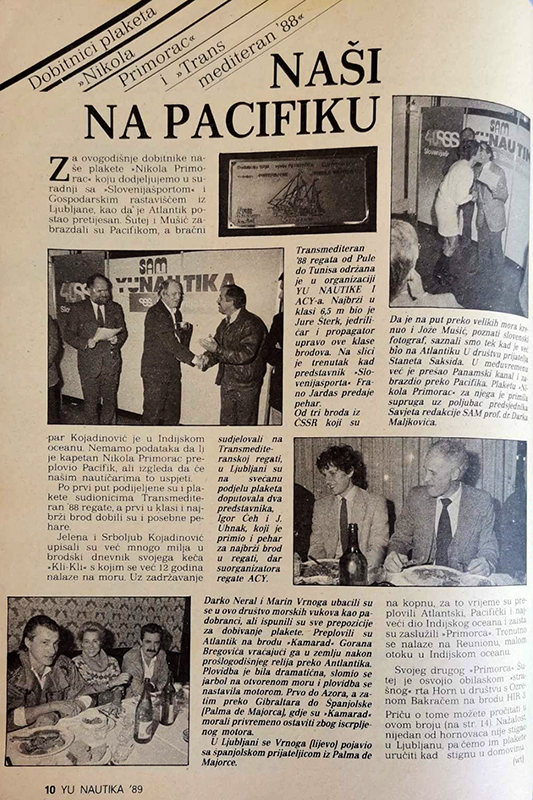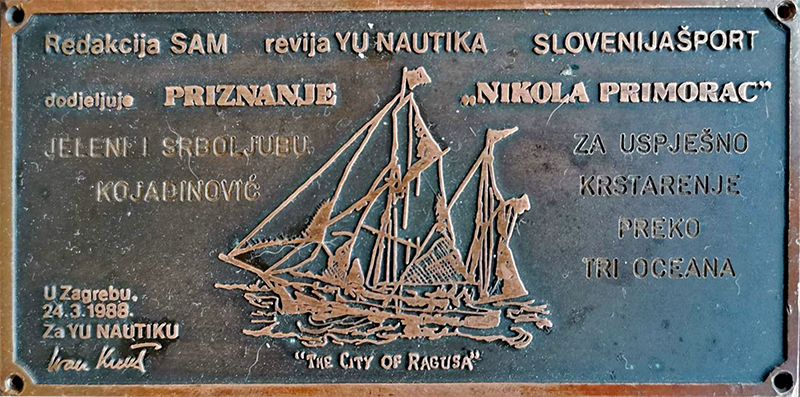The sailboat “Kli-Kli” and the owners Jelena and Srboljub Kojadinović got the plaque “Nikola Primorac”. The plaque was issued by the editorial board of “SAM” (Sam Svoj Majstor), a special edition journal dedicated to Nautica – YU Nautika. They awarded the plaque for successful navigation of the three oceans.
A brass plate of 12 by 6 cm, in a shallow etching, shows a “City of Ragusa” sailboat with inscriptions and graved dedication to Kojadinović’s. The plaque was issued in Zagreb on 24. March 1988. In-chief Ivan Kreutz handed it to, during the annual conference of “SAM” and handed it over to a representative of the Kojadinović family.

Today, the plaque is on display at the salon of our sailboat “Kli-Kli”.
But who was Nikola Primorac, and what was he famous for?
Nikola Primorac (born: Dubrovnik 27. July 1840—died: Liverpool 1. March 1886) was a Croatian expat in England. By the trade, he was a shipmaster, but his license was revoked after shipwrecking the Austro-Hungarian merchant ship at the banks of Goodwin Sands, the southeastern cape at the Strait of Dover. The Incident took the lives of his wife and two children who drowned.
In historical documents and newspapers of the time, Nikola was often called by the name derived from translation: Pietro Di Costa. Surname Primorac in Croatian means “of the coast” or “di Costa” in Italian. This is the name that refers to him in the “City of Ragusa” ship’s logs.
1870 he found himself in a seaman bar in Liverpool. The bar was a place where the crew from all over the world used to gather. Circumstances at the bar were unknown, but Primorac made a bet with one Englishman for £1,000 that he would cross the Atlantic on a small boat.
The late 19th century was the time when attempting to break the records was sensational news. The London Times wrote: “It is an incredibly brave and crazy adventure ever made that could turn into tragedy or triumph”.
And the amount of money in bet was considerable, approximately a five-year salary of the shipmaster.
The crew
Various historical data and documents narrate different tales about the crew, roles, places of embankment, names, and nationalities. What we can be sure of is that Primorac had two different companions and two innocent victims (dogs) on his voyages.
John Charles Buckley
Buckley at the time of the adventure, was 34. By that time, he had fought in the Crimea, been to sea, fought in the Pope’s army, been a prisoner of war, and become a knight of the Vatican.
The newspapers give a lot of coverage to John Buckley as captain of the adventure. They describe him as a proper Englishman, a showman, garrulous and charming person: “a fine-looking person, with a long flowing beard; he waved his adieu with all The Boston Journal reported the grace of an admiral of the fleet”.
John Buckley accompanied Primorac on the first leg of the trip from Liverpool to Boston. To prepare for the trip, Buckey had an essential role in advertising the adventure and providing equipment and food for the trip. When a letter needed to be written, or they should make an interview, it was Buckley’s voice to be heard. He showed excellent art of promotion and scavenging, a lot of newspapers actually took for granted that the adventure was his project, and he was the sole instigator of the adventure.
At the end of the first leg in Boston, because of his poor health, Buckey left Primorac and returned home to Ireland. Under his parental care, he recovered his health soon.
Edward R.W. Hayter
Edwin Hayter, a New Zealander, in a time of embarkment at the “City of Ragusa“, was a 25-year-old seaman officer. Primorac found him in Boston. Hayter accompanied him on the second leg of the trip. Unfortunately, there are no more details about him.
Noštromo, the dog (s)
Nikola Primorac on his trips has two different dogs on board the “City of Ragusa“. Both dogs shared the same name “Noštromo” or Boatswain.
Noštromo (dalmatian dialect) or translated to English – boatswain or boatswain. Boatswain is the rank of the most senior of the deck crew. He handles the components of a ship’s hull and supervision the other members of the ship’s deck department.
The first barking companion, Noštromo’s breed, was not known. Unfortunately, the poor dog was washed out by the wave. He was scared and jumped on the deck during the one storm. The second Noštromo was a brindled American bull terrier. He accompanies the crew during the second leg of the trip. Fortunately, he survived the trip back and served his master for years to come.
The boat “City of Ragusa”

“The City of Ragusa is the smallest vessel ever cleared at the Liverpool Customs House, and the gentleman who performed that duty for her also cleared the Great Eastern”
From the report by The Graphic
The City of Ragusa of Liverpool, no. 2,020, is named after Dubrovnik, the city of Nikola Primorac’s birth. It was a wooden utility boat of the whaling ship “Breeze”. 6.09 m long (20ft) with a beam of 1.82m and 1.5t (3360lb) of iron ballast. Primorac has built two masts and a bowsprit. The sailing rig allowed him to spread altogether 59 m2 (70 square yards) of sails in eight or nine sails. The tanks of the “City of Ragusa” took 450 litres of water (100 imperial gallons), and she could carry three months of victuals.
It was purchased by Primorac in 1870. He had refurbished, decked, and yawl-rigged by himself, and under the supervision of J.C. Buckley. Later, Buckey received much local support as victualling for the expedition.
“City of Ragusa” heritage
The “City of Ragusa” is the first of “the smallest boats” that crossed the Atlantic oceans in both directions.
The first leg of the journey started in June 1870. It took them 93 days to arrive in Boston on September 9th. This part of the trip was not pleasant at all. Many storms hit them, they lost a lot of stuff, and the dog was unfortunately washed overboard.
Primorac waited for better weather until the summer of 1871 to sail back west to east. The City of Ragusa was exhibited at an Agricultural Fair in Boston where among others it was visited by US President Ulysses S Grant. The boat needed necessary repairs to be done during the spring.
The City of Ragusa set sail on May 23rd 1871. The return voyage was much faster, and it took them just 36 days from Boston to Queenstown, arriving at Liverpool on July 10th 1871. than the outbound trip. This trip also was not without trouble. They suffered some storms early on, which damaged sails.
Nikola Primorac becomes the first man to travel both ways across the Atlantic in a small boat.
After successful navigation, the City of Ragusa was on display of the Liverpool Museum until it was destroyed during World War II.
Wind turbine
A very interesting fact is that before the mizzen mast was a windmill that powered a two-bladed screw propeller. This solution was not effective, and it was dismantled. Various historical data and documents have different information here, too: by one, the windmill is abandoned on the return, by the other, on trailing the ship at Liverpool Bay and the Irish sea, it was ditched early in Queenstown.

But, perhaps, Primorac had high hopes the rig would work, and this was the first step towards making a fortune from his invention.
References and suggestions for further readings:
- Liverpool Miscellany: The City of Ragusa – Kapetan Nikola Primorac
- … not so epic: City of Ragusa
- Croatia.org: The boat “The City of Ragusa” of Captain Nicholas Primorac was exhibited in the Liverpool Museum
- Wikipedia: City of Ragusa
- Talk: City of Ragusa


